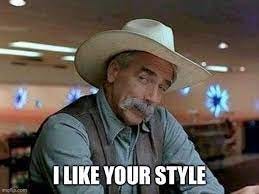Style refers to following a standard set of Editorial Directions in spelling, punctuation, capitalization, and typographical display. The Elements of Style by E. B. Strunk is probably the quintessential book on writing styles.
In Strunk's book, you will learn how to write successfully in the five main types of writing; expository, persuasive, narrative, descriptive, and creative. Each one serves a different purpose and employs different techniques to accomplish it.
That's probably not what my readers are talking about. What I think they are referring to is how I express myself using my unique vocabulary, turn of phrase, pacing, life experiences, and worldview. Or better stated, my technique. USC Rossier says writing technique can be divided into three categories: argumentive, writing to persuade, informative, writing to explain, and narrative, writing to convey real or imagined experiences.”
In novel writing, I use all three to reach my target audience. And apparently, it's working because as I said, I have many returning readers. If they didn't like my "Style," they wouldn't be back, so I must be doing something right.
Style is what differentiates one author from another. It's why some readers like Pros versus Narrative, Poetry rather than Stories, Horror vs Romance, and Fiction vs Non-Fiction. They all have their unique "Styles."
And then there are the Authors. I recently finished reading Master and Commander by Patrick O'Brian. His "Style," was quite wordy and descriptive. What would have taken me a sentence to say, he took a paragraph. Scenes he considered important to include, I felt weren't necessary. So did the movie producer. But each to their own.
A writing technique, on the other hand, is a style an author uses to convey their message in a manner that is effective and meaningful to their audience. Understanding the different types of writing techniques is important to professionals because you will need to change your style of writing to make a connection with your audience. As an author, I often use different techniques depending on the novel I'm writing. Historical Fiction needs to be set in the era, setting, geography, demography, and linguistics all play a part in how I tell the story. Check out Sins of the Fathers, Sins of the Mothers, and The Adventures of a Thief and a Princess.
On the other hand, a Mystery Novel set in modern times demands its own set of standards. Location, Location, Location. Timing, Characters, Goals, and Motivation all must be woven into the story. Check out my trilogy - The Trace O'Reilly Mystery Series. By the way, Million Dollar Murder and Snap Shot of a Killer are now available as audiobooks. They can be purchased on Amazon, Barnes and Noble, and on New Life Publication On-Line as an MP3 (sorry, I couldn't help myself).
Style and technique are what keep readers coming back for more. So as you turn the last page of your latest book, or slice your finger across the screen and see the words "The End," think of how much went into the writing of that book, or poem and if possible tell its author..."I liked your Style."




